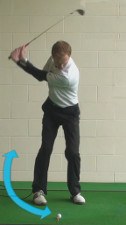
In golf, the backswing refers to the first part of the golf swing, where the golfer takes the club back away from the ball. It is the initial movement that sets up the swing and prepares the golfer for the downswing, which is the second part of the swing where the club moves forward to strike the ball.
During the backswing, the golfer's body and arms rotate to create torque and generate power. The hands, arms, and shoulders work together to bring the club up and back, while the hips and legs provide stability and balance. The backswing is crucial for setting the correct swing path, clubface position, and angle of attack, which greatly influence the direction and trajectory of the golf ball.
The length and speed of the backswing can vary depending on the golfer's style and the desired shot. Generally, a full backswing allows for more power and distance, but it also requires more control and timing to execute correctly. Golfers often practice their backswing to develop consistency and proper technique.
It's important to note that the backswing is just one component of the golf swing, and it should seamlessly transition into the downswing and follow-through to create a fluid and efficient motion. The overall goal is to achieve a balanced and rhythmic swing that maximizes distance, accuracy, and control.
Backswing: The initial section of the swing in which the golfer pulls the club away from its position behind the ball. The backswing ends when the golfer begins his movement back toward the ball (the downswing).





